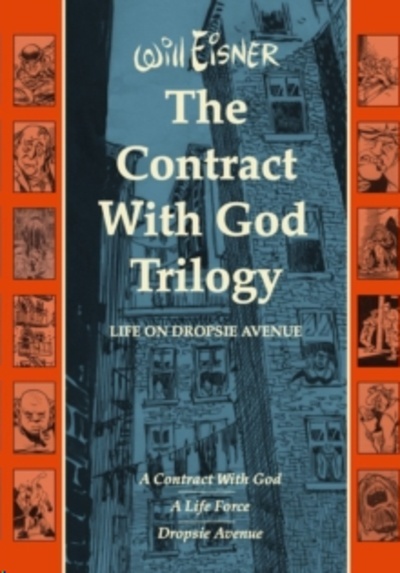The Contract with God Trilogy : Life on Dropsie Avenue

Editorial Norton
Fecha de edición noviembre 2019 · Edición nº 1
Idioma inglés
EAN 9780393061055
528 páginas
Libro
encuadernado en tapa dura
Resumen del libro
Will Eisner (1917-2005) saw himself as "a graphic witness reporting on life, death, heartbreak, and the never-ending struggle to prevail." The publication of A Contract With God when Eisner was sixty-one proved to be a watershed moment both for him and for comic literature. It marked the birth of the modern graphic novel and the beginning of an era when serious cartoonists could be liberated from their stultifying comic-book format. More than a quarter-century after the initial publication of A Contract With God, and in the last few months of his life, Eisner chose to combine the three fictional works he had set on Dropsie Avenue, the mythical street of his youth in Depression-era New York City.
As the dramas unfold in A Contract With God, the first book in this new trilogy, it is at 55 Dropsie Avenue where Frimme Hersh, the pious Jew, first loses his beloved daughter, then breaks his contract with his maker, and ends up as a slumlord; it is on Dropsie Avenue where a street singer, befriended by an aging diva, is so beholden to the bottle that he fails to grasp his chance for stardom; and it is there that a scheming little girl named Rosie poisons a depraved super's dog before doing in the super as well. In the second book, A Life Force, declared by R. Crumb to be "a masterpiece," Eisner re-creates himself in his protagonist, Jacob Shtarkah, whose existential search reflected Eisner's own lifelong struggle.
Chronicling not only the Crash of 1929 and the Great Depression but also the rise of Nazism and the spread of left-wing politics, Eisner combined the miniaturist sensibility of Henry Roth with the grand social themes of novelists such as Dos Passos and Steinbeck. Finally, in Dropsie Avenue: The Neighborhood, Eisner graphically traces the social trajectory of this mythic avenue over four centuries, creating a sweeping panorama of the city and its waves of new residents-the Dutch, English, Irish, Jews, African Americans, and Puerto Ricans-whose faces changed yet whose lives presented an unending "story of life, death, and resurrection." The Contract With God Trilogy is a mesmerizing, fictional chronicle of a universal American experience and Eisner'' most poignant and enduring literary legacy.
Biografía del autor
William Eisner (Nueva York, 1917-Florida, 2005) fue un influyente historietista estadounidense, creador del famoso personaje The Spirit en 1941 y popularizador del concepto de novela gráfica a partir de 1978. Además de su carrera como historietista, Eisner enseñó las técnicas del cómic en la Escuela de Artes Visuales de Nueva York, y escribió dos obras fundamentales del género: 'El cómic y el arte secuencial' ('Comics and Sequential Art', 1985) y 'La narración gráfica' ('Graphic Storytelling and Visual Narrative', 1996).<br> <br> La obra de Eisner tuvo una importancia decisiva para sacar a la historieta de su confinamiento como medio de entretenimiento para niños y adolescentes y presentarla a un público adulto. En su honor en 1988 se crearon los Premios Will Eisner, entregados anualmente en la Convención Internacional de Cómics de San Diego (California, Estados Unidos). <br> <br> Eisner fue un participante regular en la ceremonia de entrega de los premios hasta el año de su muerte. Eisner recibió numerosos premios internacionales, entre ellos el Premio Haxtur a la Mejor Historieta Larga por La Avenida Dropsie y al Autor que Amamos en el Salón Internacional del Cómic de Asturias en 1995 y el Premio Haxtur a la Mejor Historieta Corta por Un anillo de boda especial en el Salón Internacional del Cómic de Asturias en el 2002.<br> <br> En 1978, Eisner comenzó a publicar con regularidad las novelas gráficas: 'Contrato con Dios' ('A Contract With God'), que narra cuatro historias acerca de la vida en el Bronx en los años 30; la parábola de ciencia ficción 'Vida en otro planeta' ('Life on Another Planet'), las semiautobiográficas 'El soñador' ('The Dreamer', 1986) y 'Viaje al corazón de la tormenta' ('To the Heart of the Storm', 1991) y los agudos comentarios sobre la vida moderna en 'El edificio' ('The Building', 1987) y 'Gente invisible' ('Invisible People', 1991-1992), entre otras. Un mes antes de su muerte concluyó la que ha sido considerada su obra más política, 'La conspiración' ('The Plot', 2005), una suerte de ensayo gráfico sobre la historia de la monografía antisemita 'Protocolos de los sabios de Sion'.








